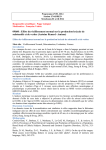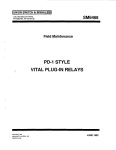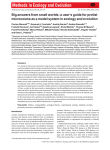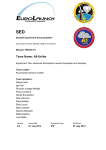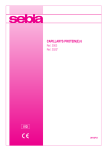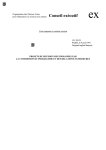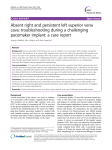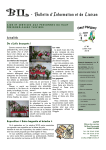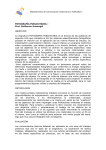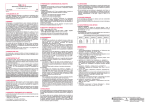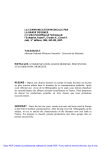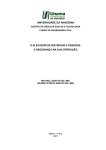Download IFU - DRG International
Transcript
DRG® Cystatin C (human) ELISA (EIA-4394) REVISED 1 JUNE 2012 RM (VERS. 11.1) RUO IN THE USA This kit is intended for Research Use Only. Not for use in diagnostic procedures. Please use only the valid version of the package insert provided with the kit. 1 INTENDED USE The Cystatin C (human) ELISA is a sandwich enzyme immunoassay for easurement of human cystatin C Features The total assay time is less than 2 hours. The kit measures total cystatin C in serum, plasma (EDTA, citrate, heparin), urine and cerebrospinal fluid. Assay format is 96 wells. Quality Controls are human serum or human urine native protein based. No animal sera are used. Standard is purified native protein based. Components of the kit are provided ready to use or concentrated. Convenient for automatization. 2 STORAGE, EXPIRATION Store the complete kit at 2 °C – 8 °C. Under these conditions, the kit is stable until the expiration date (see label on the box). 3 TEST PRINCIPLE In the Human Cystatin C ELISA, standards, quality controls and samples are incubated in microtitrate plate wells precoated with polyclonal anti-human cystatin C antibody. After 30 minutes incubation and washing, polyclonal anti-human cystatin C antibody, conjugated with horseradish peroxidase (HRP) is added to the wells and incubated for 30 minutes with captured cystatin C. Following another washing step, the remaining HRP conjugate is allowed to react with the substrate solution (TMB). The reaction is stopped by addition of acidic solution and absorbance of the resulting yellow product is measured The absorbance is proportional to the concentration of cystatin C. A standard curve is constructed by plotting absorbance values against concentrations of cystatin C standards, and concentrations of unknown samples are determined using this standard curve. 4 PRECAUTIONS For professional use only. Wear gloves and laboratory coats when handling kit materials. Do not drink, eat or smoke in the areas where kit materials are being handled. DRG International, Inc., USA Fax: (908) 233 0758 e-mail: [email protected] 1 DRG® Cystatin C (human) ELISA REVISED 1 JUNE 2012 RM (VERS. 11.1) (EIA-4394) RUO IN THE USA This kit contains components of human origin. These materials were found non-reactive for HBsAg, HCV antibody and for HIV 1/2 antigen and antibody. However, these materials should be handled as potentially infectious, as no test can guarantee the complete absence of infectious agents. Avoid contact with the acidic Stop Solution and Substrate Solution, which contains hydrogen peroxide and tetramethylbenzidine (TMB). Wear gloves and eye and clothing protection when handling these reagents. Stop and/or Substrate Solutions may cause skin/eyes irritation. In case of contact with the Stop Solution and the Substrate Solution wash skin/eyes thoroughly with water and seek medical attention, when necessary. The materials must not be pipetted by mouth. 5 TECHNICAL HINTS Reagents with different lot numbers should not be mixed. Use thoroughly clean glassware. Use deionized (distilled) water, stored in clean containers. Avoid any contamination among samples and reagents. For this purpose, disposable tips should be used for each sample and reagent. Substrate Solution should remain colourless until added to the plate. Keep Substrate Solution protected from light. Stop Solution should remain colourless until added to the plate. The colour developed in the wells will turn from blue to yellow immediately after the addition of the Stop Solution. Wells that are green in colour indicate that the Stop Solution has not mixed thoroughly with the Substrate Solution. Dispose of consumable materials and unused contents in accordance with applicable national regulatory requirements. DRG International, Inc., USA Fax: (908) 233 0758 e-mail: [email protected] 2 DRG® Cystatin C (human) ELISA (EIA-4394) REVISED 1 JUNE 2012 RM (VERS. 11.1) 6 RUO IN THE USA REAGENT SUPPLIED Kit Components State Quantity Antibody Coated Microtiter Strips ready to use 96 wells Conjugate Solution Conc. (50x) concentrated 0.26 mL Conjugate Diluent ready to use 13 mL Set of Standards concentrated 6 x 0.1 mL Quality Control HIGH concentrated 0.1 mL Quality Control LOW concentrated 0.1 mL Dilution Buffer Conc. (10x) concentrated 10 mL Wash Solution Conc. (10x) concentrated 100 mL Substrate Solution ready to use 13 mL Stop Solution ready to use 13 mL Product Data Sheet + Certificate of Analysis 1 pc 7 MATERIAL REQUIRED BUT NOT SUPPLIED Deionized (distilled) water Test tubes for diluting samples Glassware (graduated cylinder and bottle) for Wash Solution (Dilution Buffer) Precision pipettes to deliver 10-1000 µL with disposable tips Multichannel pipette to deliver 100 µL with disposable tips Absorbent material (e.g. paper towels) for blotting the microtitrate plate after washing Vortex mixer Orbital microplate shaker capable of approximately 300 rpm Microplate washer (optional). [Manual washing is possible but not preferable.] Microplate reader with 450 ± 10 nm filter, preferably with reference wavelength 630 nm (alternatively another one from the interval 550-650 nm) Software package facilitating data generation and analysis (optional) 8 PREPARATION OF REAGENTS All reagents need to be brought to room temperature prior to use. Always prepare only the appropriate quantity of reagents for your test. Do not use components after the expiration date marked on their label. DRG International, Inc., USA Fax: (908) 233 0758 e-mail: [email protected] 3 DRG® Cystatin C (human) ELISA REVISED 1 JUNE 2012 RM (VERS. 11.1) (EIA-4394) RUO IN THE USA Assay reagents supplied ready to use: Antibody Coated Microtiter Strips Stability and storage: Return the unused strips to the provided aluminium zip-sealed bag with desiccant and seal carefully. Remaining Microtiter Strips are stable 3 months stored at 2 °C - 8 °C and protected from the moisture. Conjugate Diluent Substrate Solution Stop Solution Stability and storage: Opened reagents are stable 3 months when stored at 2 °C - 8 °C. Assay reagents supplied concentrated: Dilution Buffer Conc. (10x) Dilute Dilution Buffer Concentrate (10x) ten-fold in 90 mL distilled water to prepare a 1x working solution, e.g. 10 mL of Dilution Buffer Concentrate (10x) + 90 mL of distilled water for use of all 96-wells. It is recommended to dilute only such a volume of Dilution Buffer Concentrate (10x) to be used up in the one run of the test. Stability and storage: The diluted Dilution Buffer is stable 1 week when stored at 2 °C - 8 °C. Opened Dilution Buffer Concentrate (10x) is stable 3 months when stored at 2 °C - 8 °C. Set of Standards Dilute each concentration of Standard 400x with the Dilution Buffer just prior to the assay in two steps as follows: Dilution A (10x): Add 10 µL of Standard into 90 µL of Dilution Buffer. Mix well (not to foam). Vortex is recommended. Dilution B (40x): Add 10 µL of Dilution A into 390 µL of Dilution Buffer to prepare final dilution (400x). Mix well (not to foam). Vortex is recommended. Stability and storage: Opened Standards are stable 3 months when stored at 2 °C - 8 °C. Do not store the diluted set of Standards. Quality Controls High, Low Refer to the Certificate of Analysis for current Quality Control concentration!!! Dilute each Quality Control (QC) 400x with the Dilution Buffer just prior to the assay in two steps as follows: DRG International, Inc., USA Fax: (908) 233 0758 e-mail: [email protected] 4 DRG® Cystatin C (human) ELISA REVISED 1 JUNE 2012 RM (VERS. 11.1) (EIA-4394) RUO IN THE USA Dilution A (10x): Add 10 µL of QC into 90 µL of Dilution Buffer. Mix well (not to foam). Vortex is recommended. Dilution B (40x): Add 10 µL of Dilution A into 390 µL of Dilution Buffer to prepare final dilution (400x). Mix well (not to foam). Vortex is recommended. Stability and storage: Opened Quality Controls are stable 3 months when stored at 2 °C - 8 °C. Do not store the diluted Quality Controls. Note: Concentration of analyte in Quality Controls need not be anyhow associated with normal and/or pathological concentrations in serum or another body fluid. Quality Controls serve just for control that the kit works in accordance with the user’s manual and CoA and that ELISA test was carried out properly. It is recommended to supplement two or three negative sample controls of customer´s own (in addition to those provided with this kit). They can serve as evidence of the difference between positive and negative samples (see Figure 5 and Figure 6). Conjugate Solution Conc. (50x) Prepare the working Conjugate Solution by adding 1 part concentrated Conjugate Solution Concentrate (50x) with 49 parts Conjugate Diluent. Example: 0.25 mL of Conjugate Solution Concentrate (50x) + 12.25 mL of Conjugate Diluent for use of all 96-wells. Prepare only the volume needed for the test. Mix well (not to foam). Stability and storage: Opened Conjugate Solution Concentrate (50x) is stable 3 months when stored at 2 °C - 8 °C. Do not store the diluted Conjugate Solution. Wash Solution Conc. (10x) Dilute Wash Solution Concentrate (10x) ten-fold in 900 mL of distilled water to prepare a 1x working solution, e.g. 100 mL of Wash Solution Concentrate (10x) + 900 mL of distilled water for use of all 96-wells. Stability and storage: The diluted Wash Solution is stable 1 month when stored at 2 °C - 8 °C. Opened Wash Solution Concentrate (10x) is stable 3 months when stored at 2 °C - 8 °C. 9 PREPARATION OF SAMPLES The kit measures cystatin C in serum, plasma (EDTA, citrate, heparin), urine and cerebrospinal fluid. Samples should be assayed immediately after collection or should be stored at -20 °C. Mix thoroughly thawed samples just prior to the assay and avoid repeated freeze/thaw cycles, which may cause erroneous results. Avoid using hemolyzed or lipemic samples. DRG International, Inc., USA Fax: (908) 233 0758 e-mail: [email protected] 5 DRG® Cystatin C (human) ELISA REVISED 1 JUNE 2012 RM (VERS. 11.1) (EIA-4394) RUO IN THE USA Dilute samples (serum, plasma) 400x with the Dilution Buffer just prior to the assay in two steps as follows: Dilution A (10x): Add 10 µL of sample into 90 µL of Dilution Buffer. Mix well (not to foam). Vortex is recommended. Dilution B (40x): Add 10 µL of Dilution A into 390 µL of Dilution Buffer to prepare final dilution (400x). Mix well (not to foam). Vortex is recommended. Dilute samples (CSF) 1600x with the Dilution Buffer just prior to the assay as follows: Dilution A (40x): Add 10 μl of sample into 390 μl of Dilution Buffer. Mix well (not to foam). Vortex is recommended. Dilution B (40x): Add 10 μl of Dilution A into 390 μl of Dilution Buffer to prepare final dilution (1600x). Mix well (not to foam). Vortex is recommended. Stability and storage: Samples should be stored at -20 °C, or preferably at -70 °C for long-term storage. Avoid repeated freeze/ thaw cycles. Do not store the diluted samples. For dilution of urine samples see Chapter 15. See Chapter 13 for stability of serum and plasma samples when stored at 2 °C - 8 °C, effect of freezing/thawing and effect of sample matrix (serum/plasma) on the concentration of cystatin C. Note: It is recommended to use a precision pipette and a careful technique to perform the dilution in order to get precise results. DRG International, Inc., USA Fax: (908) 233 0758 e-mail: [email protected] 6 DRG® Cystatin C (human) ELISA REVISED 1 JUNE 2012 RM (VERS. 11.1) (EIA-4394) RUO IN THE USA 10 ASSAY PROCEDURE 1. Pipet 100 µL of diluted Standards, Quality Controls, Dilution Buffer (=Blank) and samples, preferably in duplicates, into the appropriate wells. See Figure 1 for example of work sheet. 2. Incubate the plate at room temperature (ca. 25 °C) for 30 minutes, shaking at ca. 300 rpm on an orbital microplate shaker. 3. Wash the wells 3-times with Wash Solution (0.35 mL per well). After final wash, invert and tap the plate strongly against paper towel. 4. Add 100 µL of Conjugate Solution into each well. 5. Incubate the plate at room temperature (ca. 25 °C) for 30 minutes, shaking at ca. 300 rpm on an orbital microplate shaker. Incubation without shaking is an alternative that requires extended incubation with substrate – see step 8 below. 6. Wash the wells 3-times with Wash Solution (0.35 mL per well). After final wash, invert and tap the plate strongly against paper towel. 7. Add 100 µL of Substrate Solution into each well. Avoid exposing the microtiter plate to direct sunlight. Covering the plate with e.g. aluminium foil is recommended. 8. Incubate the plate for 10 minutes at room temperature. The incubation time may be extended [up to 20 minutes] if the reaction temperature is below than 20 °C. Do not shake with the plate during the incubation. 9. Stop the colour development by adding 100 µL of Stop Solution. 10. Determine the absorbance of each well using a microplate reader set to 450 nm, preferably with the reference wavelength set to 630 nm (acceptable range: 550 - 650 nm). Subtract readings at 630 nm (550 - 650 nm) from the readings at 450 nm. The absorbance should be read within 5 minutes following step 9. Note: If some samples and standards have absorbances above the upper limit of your microplate reader, perform a second reading at 405 nm. A new standard curve, constructed using the values measured at 405 nm, is used to determine cystatin C concentration of off-scale standards and samples. The readings at 405 nm should not replace the readings for samples that were “in range” at 450 nm. Note 2: Manual washing: Aspirate wells and pipet 0.35 mL Wash Solution into each well. Aspirate wells and repeat twice. After final wash, invert and tap the plate strongly against paper towel. Make certain that Wash Solution has been removed entirely. DRG International, Inc., USA Fax: (908) 233 0758 e-mail: [email protected] 7 DRG® Cystatin C (human) ELISA (EIA-4394) REVISED 1 JUNE 2012 RM (VERS. 11.1) RUO IN THE USA strip 1+2 strip 3+4 strip 5+6 strip 7+8 strip 9+10 strip 11+12 A Standard 10 000 Blank Sample 8 Sample 16 Sample 24 Sample 32 B Standard 4 000 Sample 1 Sample 9 Sample 17 Sample 25 Sample 33 C Standard 2 000 Sample 2 Sample 10 Sample 18 Sample 26 Sample 34 D Standard 1 000 Sample 3 Sample 11 Sample 19 Sample 27 Sample 35 E Standard 400 Sample 4 Sample 12 Sample 20 Sample 28 Sample 36 F Standard 200 Sample 5 Sample 13 Sample 21 Sample 29 Sample 37 G QC High Sample 6 Sample 14 Sample 22 Sample 30 Sample 38 H QC Low Sample 7 Sample 15 Sample 23 Sample 31 Sample 39 Figure 1: Example of a work sheet. 11 CALCULATIONS Most microplate readers perform automatic calculations of analyte concentration. The standard curve is constructed by plotting the mean absorbance (Y) of Standards against the known concentration (X) of Standards in logarithmic scale, using the four-parameter algorithm. Results are reported as concentration of cystatin C ng/mL in samples. Alternatively, the logit log function can be used to linearize the standard curve i.e. logit of the mean absorbance (Y) is plotted against log of the known concentration (X) of Standards. Use values of undiluted standard range: 10 000, 4 000, 2 000, 1 000, 400, 200 ng/mL. Samples, Quality Controls and Standards are all diluted 400x prior to analysis, so there is no need to take this dilution factor into account. Results are reported as total concentration of cystatin C (ng/mL) in serum/plasma samples. For the determination of concentration in samples diluted differently, use dilution factor for dividing/multiplying results read off the standard curve. DRG International, Inc., USA Fax: (908) 233 0758 e-mail: [email protected] 8 DRG® Cystatin C (human) ELISA (EIA-4394) REVISED 1 JUNE 2012 RM (VERS. 11.1) RUO IN THE USA Human Cystatin C ELISA Standard Curve 3,5 Absorbance (A450 nm - A630 nm) 3,0 2,5 2,0 1,5 1,0 0,5 0,0 100 1000 10000 Concentration of Hu Cystatin C (ng/ml) Figure 2: Typical Standard Curve for Human Cystatin C ELISA. DRG International, Inc., USA Fax: (908) 233 0758 e-mail: [email protected] 9 DRG® Cystatin C (human) ELISA REVISED 1 JUNE 2012 RM (VERS. 11.1) (EIA-4394) RUO IN THE USA 12 DEFINITION OF THE STANDARD The Standard used in this kit is purified native protein based. 13 URINE CYSTATIN C DETERMINATION For the determination of cystatin C in urine use the serum/plasma protocol only with the following modifications: 13.1 Sample collection and storage It is recommended to freeze down untreated urine although no significant decline was observed in concentration of human cystatin C in samples stored at 4 °C for 14 days. 13.2 Sample preparation Dilute urine samples 20x with Dilution Buffer just prior to use in the assay, e.g.: 20 µL of sample + 380 µL of Dilution Buffer. Stability and storage: Untreated urine samples are stable for 3 months if stored at -20 °C/ -70 °C. Do not store the diluted samples. 13.3 Calculations of results Standard curve is plotted using values of undiluted Standards: 10 000, 4 000, 2 000, 1 000, 400 and 200 ng/mL. As urine samples are diluted only 20x whereas Standards are diluted 400x, the result (read off the Standard curve) has to be divided by dilution factor 20 in order to obtain the real concentration in the original (undiluted) sample. DRG International, Inc., USA Fax: (908) 233 0758 e-mail: [email protected] 10 DRG® Cystatin C (human) ELISA (EIA-4394) REVISED 1 JUNE 2012 RM (VERS. 11.1) RUO IN THE USA 14 TROUBLESHOOTING AND FAQS Weak signal in all wells Possible explanations: Omission of a reagent or a step Improper preparation or storage of a reagent Assay performed before reagents were allowed to come to room temperature Improper wavelength when reading absorbance High signal and background in all wells Possible explanations: Improper or inadequate washing Overdeveloping; incubation time with Substrate Solution should be decreased before addition of Stop Solution Incubation temperature over 30°C High coefficient of variation (CV) Possible explanation: Improper or inadequate washing Improper mixing Standards, Quality Controls or samples DRG International, Inc., USA Fax: (908) 233 0758 e-mail: [email protected] 11 DRG® Cystatin C (human) ELISA REVISED 1 JUNE 2012 RM (VERS. 11.1) (EIA-4394) RUO IN THE USA 15 REFERENCES Ekiel I, Abrahamson M, Fulton DB, Lindahl P, Storer AC, Levadoux W, Lafrance M, Labelle S, Pomerleau Y, Groleau D, LeSauteur L, Gehring K: NMR structural studies of human cystatin C dimmers and monomers. J Mol Biol. 271: 266-277 (1997) Tian S, Kusano E, Ohara T, Tabei K, Itoh Y, Kawai T, Asano Y: Cystatin C measurement and its practical use in patients with various renal diseases. Clin Nephrol. 48: 104-108 (1997) Bokenkamp A, Domanetzki M, Zinck R, Schumann G, Byrd D, Brodehl J: Cystatin C – a new marker of glomerular filtration rate in children independent of age and height. Pediatrics. 101: 875-881 (1998) Risch L, Blumberg A, Huber A: Rapid and accurate assessment of glomerular filtration rate in patients with renal transplants using serum cystatin C. Nephrol Dial Transplant. 14: 1991-1996 (1999) Deng A, Irizarry MC, Nitsch RM, Growdon JH, Rebeck GW: Elevation of cystatin C in susceptible neurons in Alzheimer's disease. Am J Pathol. 159: 1061-1068 (2001) Dharnidharka VR, Kwon C, Stevens G: Serum cystatin C is superior to serum creatinine as a marker of kidney function: a meta-analysis. Am J Kidney Dis. 40: 221-226 (2002) Mojiminiyi OA and Abdella N: Evaluation of cystatin C and beta-2 microglobulin as markers of renal function in patients with type 2 diabetes mellitus. J Diabetes Complications. 17: 160-168 (2003) Perlemoine C, Beauvieux MC, Rigalleau V, Baillet L, Barthes N, Derache P, Gin H: Interest of cystatin C in screening diabetic patients for early impairment of renal function. Metabolism. 52: 1258-1264 (2003) Mussap M and Plebani M: Biochemistry and Clinical Role of Human Cystatin C. Crit Rev Clin Lab Sci. 41: 467-550 (2004) Johnston N, Jernberg T, Lindahl B, Lindback J, Stridsberg M, Larsson A, Venge P, Wallentin L: Biochemical indicators of cardiac and renal function in a healthy elderly population. Clin Biochem. 37: 210-216 (2004) Luc G, Bard JM, Lesueur C, Arveiler D, Evans A, Amouyel P, Ferrieres J, Juhan-Vague I, Fruchart JC, Ducimetiere P: Plasma cystatin-C and development of coronary heart disease: The PRIME Study. Atherosclerosis. (2005) Macisaac RJ, Tsalamandris C, Thomas MC, Premaratne E, Panagiotopoulos S, Smith TJ, Poon A, Jenkins MA, Ratnaike SI, Power DA Jerums G: Estimating glomerular filtration rate in diabetes: a comparison of cystatin-C- and creatinine-based methods. Diabetologia. 49: 1686-1689 (2006) Nakashima I, Fujihara K, Fujinoki M, Kawamura T, Nishimura T, Nakamura M, Itoyama Y: Alteration of cystatin C in the cerebrospinal fluid of multiple sclerosis. Ann Neurol. (2006) Delanaye P, Cavalier E, Krzesinski JM.: Cystatin C, renal function, and cardiovascular risk. Ann Intern Med. Jul 3;147(1):19-27 (2007) Parikh NI, Hwang SJ, Yang Q, Larson MG, Guo CY, Robins SJ, Sutherland P, Benjamin EJ, Levy D, Fox CS: Clinical correlates and heritability of cystatin C (from the Framingham Offspring Study). Am J Cardiol. Nov 1;102(9):1194-8 (2008) Sundelöf J, Arnlöv J, Ingelsson E, Sundström J, Basu S, Zethelius B, Larsson A, Irizarry MC, Giedraitis V, Rönnemaa E, Degerman-Gunnarsson M, Hyman BT, Basun H, Kilander L, Lannfelt L: Serum cystatin C and the risk of Alzheimer disease in elderly men. Neurology Sep 30;71(14):1072-9 (2008) Ortiz F, Harmoinen A, Paavonen T, Koskinen P, Grönhagen-Riska C, Honkanen E: Is Cystatin C more sensitive than creatinine in detecting early chronic allograft nephropathy? Clin Nephrol. 70(1):18-25 (2008) Samouilidou EC, Grapsa E.: Relationship of serum cystatin C with C-reactive protein and apolipoprotein A1 in patients on hemodialysis. Ren Fail. 30(7):711-5(2008) DRG International, Inc., USA Fax: (908) 233 0758 e-mail: [email protected] 12 DRG® Cystatin C (human) ELISA REVISED 1 JUNE 2012 RM (VERS. 11.1) (EIA-4394) RUO IN THE USA Muntner P, Mann D, Winston J, Bansilal S, Farkouh ME.: Serum cystatin C and increased coronary heart disease prevalence in US adults without chronic kidney disease. Am J Cardiol. Jul 1;102(1):54-7 (2008) Servais A, Giral P, Bernard M, Bruckert E, Deray G, Isnard Bagnis C.: Is serum cystatin-C a reliable marker for metabolic syndrome? Am J Med. May;121(5):426-32 (2008) Muntner P, Winston J, Uribarri J, Mann D, Fox CS.: Overweight, obesity, and elevated serum cystatin C levels in adults in the United States. Am J Med. Apr;121(4):341-8 (2008) Premaratne E, MacIsaac RJ, Finch S, Panagiotopoulos S, Ekinci E, Jerums G.: Serial measurements of cystatin C are more accurate than creatinine-based methods in detecting declining renal function in type 1 diabetes. Diabetes Care. May;31(5):971-3 (2008). Moran A, Katz R, Smith NL, Fried LF, Sarnak MJ, Seliger SL, Psaty B, Siscovick DS, Gottdiener JS, Shlipak MG.: Cystatin C concentration as a predictor of systolic and diastolic heart failure. J Card Fail. Feb;14(1):19-26 (2008) Nedelkov D and Nelson RW: Delineating protein-protein interactions via biomolecular interaction analysis-mass spectrometry. J Mol Recognit. 16: 9-14 (2003) Nedelkov D and Nelson RW: Design and use of multi-affinity surfaces in biomolecular interaction analysis-mass spectrometry (BIA/MS): a step toward the design of SPR/MS arrays. J Mol Recognit. 16: 15-19 (2003) Mares J, Stejskal D, Vavrouskova J, Urbanek K, Herzig R, Hlustik P: Use of cystatin C determination in clinical diagnostics. Biomed Papers. 147: 177-180 (2003) Straface E, Matarrese P, Gambardella L, Vona R, Sgadari A, Silveri MC, Malorni W: Oxidative imbalance and cathepsin D changes as peripheral blood biomarkers of Alzheimer disease: A pilot study. FEBS Lett. 579: 2759-2766 (2005) Stejskal D, Vavrouskova J, Mares J, Urbanek K: Applications of new laboratory marker assays in neurological diagnoses - A pilot study. Biomed Pap Med Fac Univ Palacky Olomouc Czech Repub. 149: 265-266 (2005) Taleb S, Lacasa D, Bastard JP, Poitou C, Cancello R, Pelloux V, Viguerie N, Benis A, Zucker JD, Bouillot JL, Coussieu C, Basdevant A, Langin D, Clement K: Cathepsin S, a novel biomarker of adiposity: relevance to atherogenesis. FASEB J. 19: 1540-1542 (2005) Barrientos LG, Rollin PE: Release of cellular proteases into the acidic extracellular milieu exacerbates Ebola virusinduced cell damage. Virology (2006) Liu XD, Zeng BF, Xu JG, Zhu HB, Xia QC: Proteomic analysis of the cerebrospinal fluid of patients with lumbar disk herniation. Proteomics 6: 1019-1028 (2006) Yang X, Wang H, Wang Z, Dong M: Alteration and significance of serum cardiac troponin I and cystatin C in preeclampsia. Clin Chim Acta. 374: 168-169 (2006) Taleb S, Cancello R, Poitou C, Rouault C, Sellam P, Levy P, Bouillot JL, Coussieu C, Basdevant A, Guerre-Millo M, Lacasa D, Clement K: Weight loss reduces adipose tissue cathepsin S and its circulating levels in morbidly obese women. J Clin Endocrinol Metab. 91: 1042-1047 (2006) Hossain M. A., Emara M., El moselhi. H., Shoker A.: Comparing measures of Cystatin C in human sera by three methods. Am J Nephrology 29(5): 381 – 391 (2009) Wilson M. E., Boumaza I., Lacomis D., Bowser R.: Cystatin : A candidate biomarker for amyotrophic lateral sclerosis. PLoS ONE 5(12): 1 – 9 (2010) DRG International, Inc., USA Fax: (908) 233 0758 e-mail: [email protected] 13 DRG® Cystatin C (human) ELISA REVISED 1 JUNE 2012 RM (VERS. 11.1) (EIA-4394) RUO IN THE USA Tanindi A.., Olgun H., Tuncel A., Celik B., Pasaoglu H., Boyaci B.: Exercise electrocardiogrpahis responses and serum cystatin C levels among metabolic syndrome patients without overt diabetes mellitus. Vascular Health and Risk Management 7: 59 – 65 (2011) DRG International, Inc., USA Fax: (908) 233 0758 e-mail: [email protected] 14 DRG® Cystatin C (human) ELISA REVISED 1 JUNE 2012 RM (VERS. 11.1) (EIA-4394) RUO IN THE USA 3 4 5 6 7 8 9 10 11 12 16 PLATE LAYOUT DRG International, Inc., USA Fax: (908) 233 0758 e-mail: [email protected] 15 DRG® Cystatin C (human) ELISA (EIA-4394) RUO IN THE USA H G F E D C B A 1 2 REVISED 1 JUNE 2012 RM (VERS. 11.1) Rev. 5/16/12cc DRG International, Inc., USA Fax: (908) 233 0758 e-mail: [email protected] 16
















